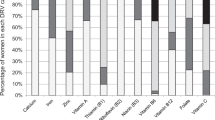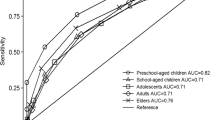Abstract
Objective:
To monitor the dietary intake of energy, macro- and micronutrients in asylum seeker children.
Design and setting:
Cross-sectional study in three asylum seeker centres in The Netherlands.
Subjects:
Hundred and sixteen children 2–12 years old (86% of the study cohort) provided a dietary history.
Method:
The dietary intake was estimated by 24 h recall, and the origin of the children was classified in three geographic regions: African (n=45), Central Asia (n=34) or Eastern Europe (n=37).
Results:
The total energy intake from fat was in 24% of the children above 40En%. Seventy per cent of the children above 4 year of age had a saturated fat intake above 10En%. The children from Eastern Europe had a higher intake of fat and disaccharides than the children from the other regions. Among the children, an intake less than 80% of the recommended daily allowances of micronutrients was found for calcium (42%), iron (49%), vitamin A (45%) and vitamin D (80%). An inadequate dietary intake of iron and vitamin D was significantly more seen among the youngest children, whereas an inadequate intake of calcium and vitamin A was found more among the elder children.
Conclusions:
The dietary intake of a prominent proportion of these children contains too much fat and insufficient amounts of calcium, iron, vitamin A and vitamin D. The low micronutrient intake of the asylum seeker children can be considered as a nutritional risk. Nutritional education and strategies to improve the macro- and micronutrient intake of asylum seeker children is indicated.
This is a preview of subscription content, access via your institution
Access options
Subscribe to this journal
Receive 12 print issues and online access
$259.00 per year
only $21.58 per issue
Buy this article
- Purchase on Springer Link
- Instant access to full article PDF
Prices may be subject to local taxes which are calculated during checkout


Similar content being viewed by others
References
Ballew C, Kuester S, Serdula M, Bowman B, Dietz W (2000). Nutrient intakes and dietary patterns of young children by dietary fat intakes. J Pediatr 136, 181–187.
Becker W, Welten D (2001). Under-reporting in dietary surveys – implications for development of food-based dietary guidelines. Public Health Nutr 4, 683–687.
Biro G, Hulshof KF, Ovesen L, Amorim Cruz JA (2002). Selection of methodology to assess food intake. Eur J Clin Nutr 56 (Suppl 2), S25–S32.
Brussaard JH, Erp-Baart MA, Brants A, Hul KF (2000). Voedselconsumptie en voedingtoestand bij 8-jarige Marokkaanse, Turkse en Nederlandse kinderen en hun moeders. TNO Voeding: Wageningen.
Brussaard JH, Erp-Baart MA, Brants HA, Hulshof KF, Lowik MR (2001). Nutrition and health among migrants in The Netherlands. Public Health Nutr 4, 659–664.
COA (2002). Anual Report 2002. COA: Rijswijk.
Cole TJ, Bellizzi MC, Flegal KM, Dietz WH (2000). Establishing a standard definition for child overweight and obesity worldwide: international survey. BMJ 320, 1240–1243.
Dixon LB, McKenzie J, Shannon BM, Mitchell DC, Smiciklas-Wright H, Tershakovec AM (1997). The effect of changes in dietary fat on the food group and nutrient intake of 4- to 10-year-old children. Pediatrics 100, 863–872.
Fredriks AM, van Buuren S, Wit JM, Verloove-Vanhorick SP (2000). Body index measurements in 1996–1997 compared with 1980. Arch Dis Child 82, 107–112.
Goldberg GR, Black AE, Jebb SA, Cole TJ, Murgatroyd PR, Coward WA et al. (1991). Critical evaluation of energy intake data using fundamental principles of energy physiology: 1. Derivation of cut-off limits to identify under-recording. Eur J Clin Nutr 45, 569–581.
Health Council of the Netherlands (2000). Dietary Reference Intakes: Calcium, Vitamin D, Thiamin, Riboflavin, Niacin, Pantothenic acid, and Biotin Publication no. 2000/12 Health Council of the Netherlands: The Hague.
Health Council of the Netherlands (2001). Dietary Reference Intakes: Energy, Proteins, Fats, and Digestible Carbohydrates Publication No. 2001/19 Health Council of the Netherlands: The Hague.
Henriksen C, Eggesbo M, Halvorsen R, Botten G (2000). Nutrient intake among two-year-old children on cows' milk-restricted diets. Acta Paediatr 89, 272–278.
Landman J, Cruickshank JK (2001). A review of ethnicity, health and nutrition-related diseases in relation to migration in the United Kingdom. Public Health Nutr 4, 647–657.
Ludwig DS, Peterson KE, Gortmaker SL (2001). Relation between consumption of sugar-sweetened drinks and childhood obesity: a prospective, observational analysis. Lancet 357, 505–508.
Mardel S, Hailey PC, Mahmutovic A, Broom J, Golden MH, Franklin M et al. (1995). Micronutrient status of the besieged residents of Sarajevo: May 1993. Eur J Clin Nutr 49 (Suppl 2), S46–S61.
Meulmeester JF, Hulshof KF (1993). Dietary habits of Turkish and Moroccan children in the Netherlands. Ned Tijdschr Tandheelkd 100, 320–322.
Nelson M (2000). Childhood nutrition and poverty. Proc Nutr Soc 59, 307–315.
Nicklas TA, von Duvillard SP, Berenson GS (2002). Tracking of serum lipids and lipoproteins from childhood to dyslipidemia in adults: the Bogalusa Heart Study. Int J Sports Med 23 (Suppl 1), S39–S43.
Perez-Rodrigo C, Aranceta J (2001). School-based nutrition education: lessons learned and new perspectives. Public Health Nutr 4, 131–139.
Popkin BM (2002). An overview on the nutrition transition and its health implications: the Bellagio meeting. Public Health Nutr 5, 93–103.
Rao BS (2002). Approaches to intervention among children and adolescents. Nutr Rev 60, S118–S125.
Renzaho AM (2004). Fat, rich and beautiful: changing socio-cultural paradigms associated with obesity risk, nutritional status and refugee children from sub-Saharan Africa. Health Place 10, 105–113.
Sellen DW, Tedstone AE, Frize J (2002). Food insecurity among refugee families in East London: results of a pilot assessment. Public Health Nutr 5, 637–644.
Serra-Majem L (2001). Vitamin and mineral intakes in European children. Is food fortification needed? Public Health Nutr 4, 101–107.
Serra-Majem L, Ribas L, Garcia A, Perez-Rodrigo C, Aranceta J (2003). Nutrient adequacy and Mediterranean Diet in Spanish school children and adolescents. Eur J Clin Nutr 57 (Suppl 1), S35–S39.
Smaijkic A, Zec S, Telebak B, Filipovic-Hadziomeragic A (1995). Changes in nutrition among residents and refugees in Sarajevo during the war. Eur J Clin Nutr 49 (Suppl 2), S17–S22.
Steingrimsdottir L, Ovesen L, Moreiras O, Jacob S (2002). Selection of relevant dietary indicators for health. Eur J Clin Nutr 56 (Suppl 2), S8–S11.
Tomkins A (2001). Vitamin and mineral nutrition for the health and development of the children of Europe. Public Health Nutr 4, 91–99.
van Stuijvenberg ME, Kvalsvig JD, Faber M, Kruger M, Kenoyer DG, Benade AJ (1999). Effect of iron-, iodine-, and beta-carotene-fortified biscuits on the micronutrient status of primary school children: a randomized controlled trial. Am J Clin Nutr 69, 497–503.
Voedingscentrum (1998). Zo eet Nederland 1998; resultaten van de voedselconsumptie peiling 1998. Voedingscentrum: The Hague.
Walker SP, Grantham-McGregor SM, Powell CA, Chang SM (2000). Effects of growth restriction in early childhood on growth, IQ, and cognition at age 11 to 12 years and the benefits of nutritional supplementation and psychosocial stimulation. J Pediatr 137, 36–41.
Watson F, Kulenovic I, Vespa J (1995). Nutritional status and food security: winter nutrition monitoring in Sarajevo 1993–1994. Eur J Clin Nutr 49 (Suppl 2), S23–S32.
Acknowledgements
This paper is product of a study supported by the Medical Organisation Asylum Seekers North Netherlands. We are especially grateful to Mrs T de Vries, dietitian, who took all dietary interviews and to Professor Dr HJ Verkade for his comments on earlier scripts. Competitive interests: None declared.
Author information
Authors and Affiliations
Corresponding author
Additional information
Guarantor: CMA Bijleveld.
Rights and permissions
About this article
Cite this article
Stellinga-Boelen, A., Wiegersma, P. & Bijleveld, C. Dietary intake in asylum seeker children in The Netherlands, strongly related to age and origin. Eur J Clin Nutr 61, 104–110 (2007). https://doi.org/10.1038/sj.ejcn.1602501
Received:
Revised:
Accepted:
Published:
Issue Date:
DOI: https://doi.org/10.1038/sj.ejcn.1602501
Keywords
This article is cited by
-
Medizinische Maßnahmen bei immigrierenden Kindern und Jugendlichen – Aktualisierung vom 28.02.2018
Monatsschrift Kinderheilkunde (2018)
-
Vitamin D levels in children of asylum seekers in The Netherlands in relation to season and dietary intake
European Journal of Pediatrics (2007)



